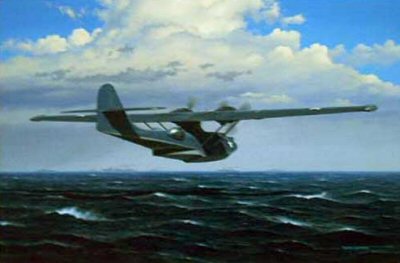Ghosts of an Era Passed
As a Student NFO back in the late 70’s (OK, 1978) in P-cola, we tended to spend a certain amount of our free time over at the (then) new-ish Naval Aviation Museum (the ‘National’ appellation still some several years off) and while our attention was drawn to some of the indoor exhibits, nicely finished and looking factory fresh, it was the ecclectic collection of “stuff” out in the back yard that was of particular interest. Included therein one could find the “Truculent Turtle” P2V, all manner of relatively recent training craft (including the T-2 and T-39, both of which we were slated to fly in VT-10, which, of course, gave pause for thought), and WF, F4D, F3D, A3D, and other items to include a couple of behemoths stuck in the far corner – the P4M Marlin and PB2Y Coronado flying boats. Now, frequent readers know of our fondness for these beasts and though appearing exceptionally forlorn and dejected in their resting spots, we wondered what the future held for them.Â
Turning to today’s CHINFO clips, looks like we have the answer to one:Â
PENSACOLA NAVAL AIR STATION, Fla. – Ed Ellis steps across the National Naval Aviation Museum into the aircraft that was Pacific Fleet commander Adm. Chester Nimitz’s flying headquarters during World War II.
“If this plane could talk,” said the 67-year-old retired Navy captain, longing to hear the conversations that happened aboard the vintage PB2Y Coronado. “Nearly every Navy admiral in the Pacific was in here.”
The Coronado – the first U.S. plane to land in Tokyo after the war – is the latest restoration project undertaken by the museum’s mostly volunteer staff of hundreds of military retirees.
 Over the years, when we were operationally flying our ground jobs comprised the bulk of the typical VAW Maintenance Department, from AE Branch O up to and including Maintenance Officer for our department head tour. During that time our esteem (and empathy) for the wrench turners, metal benders, tweaks, and rust crew would grow as well as an appreciation for the level of effort it takes to keep these flying wonders up and available, whether on the ramp at Breezy or on the flightdeck. That was hard enough, to deal with the amphib beasts who regularly flew off and onto the briny deep (and shallows), well, it is enough to make one shake one’s head in wonder that they aren’t all piles of oxided metal. It was (and still is) a labor of dedication and yes, love:
Â
Former Navy pilot Mort Eckhouse, 79, has logged thousands of volunteer hours over nearly 20 years working in the restoration area’s machine shop. The retired commander meticulously recreates rusted and broken aircraft parts on donated 1950s-era milling machines.His work is tested whenever a pilot or crew member of a restored aircraft sees the finished product in the museum.”It’s a wonderful moment when they guy who actually flew the plane comes and checks it out,” he said while working on a part used to attach the Coronado’s vertical stabilizer.
“We try to restore them as close to the factory specs as we can.”Volunteer Jeff Peyronnin, 62, has spent the last two years working on the Coronado’s tail section. He and the other volunteers like to joke that it will take another 10 years before the restoration is complete.
The museum estimates at least another three years to completion.Â
“Every time you mess with it you feel like you are touching history,” said Peyronnin, who served in the Coast Guard. “I like to picture this old lady at Tokyo Bay.”Bob Matlock, 69, served as an aircraft mechanic in Vietnam. Nowadays Matlock is using his skills replacing some 10,000 rivets in the Coronado’s tail section.Â
He winces when he thinks about the thousands of museum visitors that will climb the stairs of the restored plane and peak inside one day, scratching the paint and shaking loose some of the bolts and rivets.Many of Les Schnyder’s restoration projects are already on display inside the museum. The 82-year-old World War II veteran has logged more than 18,000 hours as a volunteer. His niche is restoring the blimp-like air ships that escorted convoys in World War II.
Schnyder, a former Navy man, worked as a civilian contractor maintaining air ships at Lakehurst Naval Air Station in New Jersey.Some of the planes were brought back to life after being pulled from the water years later. Ellis’ favorite museum aircraft is an early World War II-era Brewster Buccaneer that was at Pearl Harbor when the Japanese attacked. It later flew in the Battle of Midway and then became a training aircraft for pilots practicing carrier landings in Lake Michigan, where it sank following a crash. It was salvaged from the lake’s depths after six decades.
Wally Farrand retired after 22 years in the Navy and now restores the museum’s vintage aircraft engines, including the Buccaneer’s. As he painstakingly went over parts from the Coronado’s engine with a cleaning solvent and cloth, he joked that his best work is never seen by museum visitors because it is covered inside the aircraft.”But everything I do here, I just love it,” he said.BZ guys — the fighters and attack aircraft are neat and the restorations are to be admired, but this project is greater still if only to give homage to a rare and extraordinary creature.”back in the day”

Â
Take a moment and visit the PB2Y Organization’s site, especially the sea stories section.



I can remember the Awe when I saw that bird in the hangar there for the first time. Only later did I venture to climb inside and could imagine Nimitz sitting there as he flew to meet with Roosevelt and Macarthur. Heady stuff sitting there looking at ancient dials and smelling the smells of a vintage airplane.